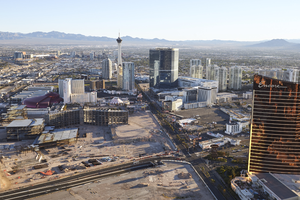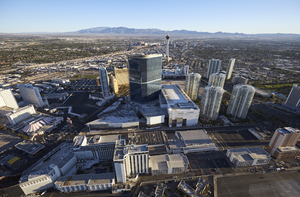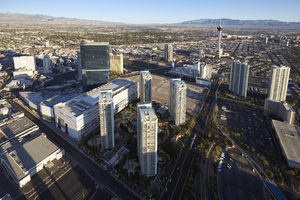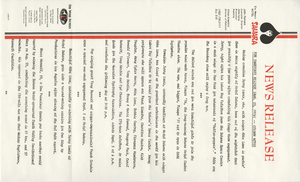Search the Special Collections and Archives Portal
Search Results

Casino Projects on the Las Vegas Strip from the Air, Las Vegas, Nevada: digital photograph
Date
Archival Collection
Description
Image

Casino Projects on the Las Vegas Strip from the Air, Las Vegas, Nevada: digital photograph
Date
Archival Collection
Description
Image

Casino Projects on the Las Vegas Strip from the Air, Las Vegas, Nevada: digital photograph
Date
Archival Collection
Description
Image

Casino Projects on the Las Vegas Strip from the Air, Las Vegas, Nevada: digital photograph
Date
Archival Collection
Description
Image

Transcript of interview with Jim Bilbray by Jeff van Ee, March 26, 2009
Date
Archival Collection
Description
Jim Bilbray served Nevada as member of the Board of Regents of the University of Nevada, chief legal counsel in the Clark County Juvenile Court, Nevada State Senator, member of the United States House of Representatives, the United States Senate, and is currently on the Board of Governors of the US Postal Service through 2015. Jim was born in Las Vegas on May 19, 1938. Among his most memorable accomplishments is his work for the environment. As a young boy growing up in Las Vegas, he loved the climate. His backyard at the family home on 3rd Street was at the edge of the city so his playground was the desert. These early years led to a lifelong appreciation for the Nevada outdoors. The 1980s and 1990s were historical for Nevada and environmental efforts. The Nevada environmental triumvirate and congressional delegation composed of Jim, Harry Reid and Richard Bryan are widely known for passing significant legislation in this field. They worked closely together, in part, because of their friendship formed while growing up together in Las Vegas. This interview helps put into perspective the pivotal role played by Congressman Bilbray. During his terms as Nevada Senator (1981 - 1987) and US Representative (1987-1995), Jim worked on a number of major public lands issues for Nevada. He helped to defuse the Sagebrush Rebellion, designate additional Forest Service wilderness, protect Red Rock as a National Conservation Area, assign the Spring Mountains as a National Recreation Area, and initiate the legislative effort to establish the Southern Nevada Public Lands Act. Jim currently resides in Las Vegas where an elementary school is named in his honor.
Text

Transcript of interview with Marie Horseley by Suzanne Becker, June 13, 2007
Date
Archival Collection
Description
Twenty years after her birth in Utah in 1924, Marie Horseley met and married her husband who was an engineer for the Union Pacific Railroad. They settled in Las Vegas, his home town and soon purchased a home for $9800 in the new John S. Park neighborhood. Sixty years later Marie, twice a widow, remains in the home. Up the street four doors, one of her granddaughters lives with her three children. Marie recalls the new housing development that appealed to railroad workers. The roads were dirt and there were no streetlights, but soon a community blossomed. Marie is a self-described quiet resident; her life was about raising her three daughters and being a member of the LDS church. However, she knew everyone on her street no matter their religious affiliation. Today the businesses are gone. Homes have changed appearances over the years as owners have changed. Ethnic diversity is apparent and the sense of community closeness has slipped away for her. Yet she loves her place there, feels safe and secure. When asked about the ides of John S. Park being designated a historic district, she is not all that wowed by the idea of restrictions that might be included in that. Nevertheless, she has no intention of relocating from the comfort of the place she has called home all these years.
Text
Fernald, Charles Nur, 1939-
Dancer Charles Nur Fernald first came to Las Vegas, Nevada in 1963 to perform for five weeks in the Kay Starr Show at the Sahara Hotel and again in 1964 working with Donn Arden for three months at the Desert Inn Hotel. Born in Detroit, Michigan, in 1939, Fernald moved several times to various places in Arizona and southern California with his parents, Charles Knox Fernald and Marguerite Marie Higgins Fernald, and half-siblings before settling in Hollywood, California, where he remained (except for his short stints in Las Vegas) from 1961 to 1967.
Person
George, Joseph Mathias, 1913-
Joseph George, was born, raised, and educated through high school in Sudlersville, Maryland. He describes his college career at the University of Pennsylvania and earning his MD degree at University of Maryland in Baltimore. There were only 15 students in his high school class and 114 in his medical class.
Person
Hannah, Don, 1929-2008
Don Hannah was a composer, arranger and musician who resided in North Las Vegas for fifty-two years. He was born February 1, 1929 in Boise, Idaho, and died October 19, 2008 in North Las Vegas.
Person

